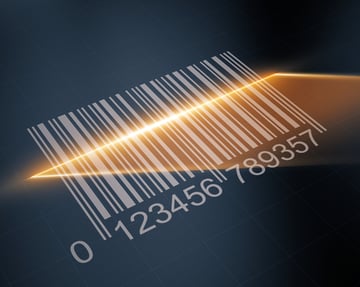The first barcode was scanned at a grocery store in Troy, Ohio in 1974. In an instant, the unassuming pack of Wrigley’s Juicy Fruit gum associated with the barcode instigated a new era of data-driven food retail. The group behind administering the standard encoded in the U.P.C. label? An entity called the Uniform Code Council (UCC), which has evolved into a non-profit dedicated to maintaining such standards world-wide. That organization is now known as GS1.
Barcodes have since become a scalable instrument for businesses to share data in accordance with GS1 open standards, which have advanced tremendously since the 1970s. From farmer to retailer, GS1 standards create a common language that enables global systems of exchange. On any given day, the barcodes transacting with this shared language are scanned over six billion times.
Food Industry Barcodes
GS1 standards are built on principles that maintain parity across supply chains, while also addressing industry-specific data sharing requirements. Barcodes can be applied at all levels of the product hierarchy, from the consumer unit to the case pack, as well as the pallet level. This creates the infrastructure for a transaction system that is dynamic and thorough, but can be difficult for companies to master. Food companies that want to automate the capture of traceability data must familiarize themselves with the GS1-128 barcode.
The Anatomy of a GS1-128
The GS1-128 (formerly UCC/EAN-128) is a variant of code 128, which can encode all ASCII alphanumeric characters in barcode format. GS1-128 defines both data types and formats that are used for exchange and logistics between entities. Food companies use this barcoding format to share company, product, and shipping information.
Below is a sample GS1-128 barcode generated for FoodLogiQ to help illustrate the way data can be communicated.
-3.png?width=750&name=GS1-128%20(1)-3.png)
For Foodservice, the industry has agreed on 3 key components:
- (01) Global Trade Item Number (GTIN)
Global Trade Item Numbers (GTINs) are globally unique identifiers for products that are encoded into the barcode. The GTIN is a 14 digit identifier comprised of four components: 1) Indicator Digit, 2) Your GS1 Company Prefix, 3) Item Reference Number, 4) Check Digit. - (AI) Date Information
The foodservice industry has agreed upon the use of 5 types of date information for the GS1-128: production date, packaging date, best before date, sell by date, or expiration date. - (10) Batch/Lot
A unit of production, inspection, and/or shipment that is uniform in terms of quantity across lots, or components within batches.
The parenthetical numbers in the barcode denote the Application Identifier (AI). AIs are two-digit numerical prefixes that correlate to specific data elements. AIs are used in barcodes and EPC-Enabled RFID tags to signify the specific type of data being relayed. Read the Voluntary GS1-128 Barcode Guideline to reference the AIs used in the Foodservice Industry.
Creating a GS1-128 Barcode
Read the GS1-128 Implementation Guide for more information on how to get started with your own GS1-128 barcodes. For tips on how to avoid common mistakes read FoodLogiQ’s Common Mistakes on GS1-128 Barcode Implementation document.
Trustwell is a GS1 Solution Partner. Trustwell's FoodLogiQ platform was built on GS1 standards in order to deliver true farm-to-fork traceability with standardized product information. Our food traceability solution provides visibility at every step throughout the food supply chain. We have multiple GS1-certified staff members ready to help you get started today.
Tag(s):
Supplier Compliance
Other posts you might be interested in
View All Posts
Trustwell News
30 min read
| May 4, 2021
Creating a Barcode for Your Food Product Label
Read More.png?length=360&name=MicrosoftTeams-image%20(20).png)
Supplier Compliance
3 min read
| June 2, 2023
Find Trustwell at GS1 Connect: Booth #21 and More!
Read More.png?length=360&name=BlogPostFeaturedImage%20(1).png)
Food Industry
4 min read
| February 24, 2022

